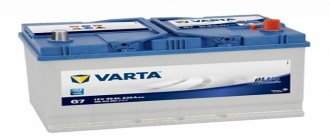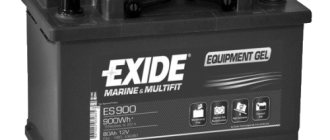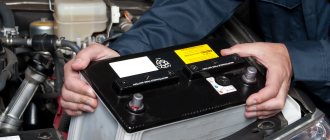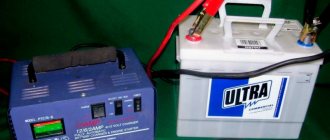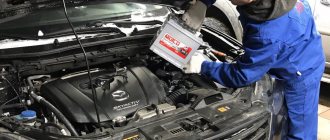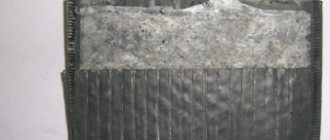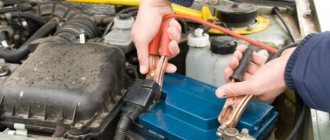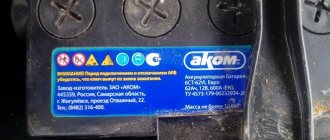Motorists are increasingly inclined to use maintenance-free batteries. According to the manufacturers, such batteries do not require special attention and at the same time work better than their well-maintained counterparts. But car batteries, regardless of type, require periodic charging to maintain functionality. To do this correctly, you need to know how to charge a maintenance-free battery, maintaining maximum capacity and quality.
How to charge a maintenance-free battery
Charging a maintenance-free battery is done in two ways:
- Direct current.
In this case, the initial current does not change, you need to change the voltage supply. For example, direct current is 2A, voltage at the beginning is 15V, and at the end of the charge is 14.3V.
- Constant tension.
In this method, the initial voltage does not change; it is enough to change the current indicators. For example, at the beginning of the process it is necessary to set the voltage to 14.4V and the current to 10A. By the end, the current may drop to 0.2A.
Charging instructions are as follows:
- Place the battery on a flat surface or leave it inside the car.
- Connect the crocodiles from the charger to the battery according to the polarity.
- Estimate the output voltage of the batteries. If the parameter is less than 11 volts, then the battery has suffered a deep discharge and it will not be possible to fully restore its capacity.
- Approximately estimate the battery charge time using the output voltage.
- Apply voltage 12.6V, observe the device for 30 minutes. If the battery has not warmed up, increase it to 14.4V.
- Monitor the decrease in parameters on the ammeter. When the lower limits of 0.5-1A are reached, stop charging.
It is recommended to charge inside a warm room. If you recharge a maintenance-free battery in the garage, you do not need to remove the battery. The main thing is to turn off possible sources of power consumption in order to properly charge the battery.
When the need may arise
Even when manufacturers of maintenance-free batteries claim that this type of battery is completely autonomous and self-sufficient, not everything turns out so perfectly. You can stop worrying about the condition of a closed car battery if the car's alternator works correctly as well as the current regulator. In such a case, the battery receives the necessary amount of charge to make up for the losses. This ensures maintenance-free batteries have a long life.
But in real conditions, such batteries retain their functionality for about 2-3 years. This happens for the following reasons:
- In the city, the amount of mileage required to restore the battery charge is not quite equal to the number of engine starts. It turns out that in order to fully charge the battery, you need to drive about 100 km or more without stopping. But in the city, engine starts and stops occur at intervals of 30-35 km or less. Under such operating conditions, the battery does not receive half the required charge.
- A relay and a special regulator are responsible for supplying the correct stable voltage from the car’s alternating current generator. But if these elements malfunction or are completely damaged, the battery does not receive a charge at all. A maintenance-free battery discharges, often beyond recovery.
- During the cold season, the battery capacity is subject to reduction. With other factors, the drop in capacity can reach 20% of the total volume.
It is impossible to completely monitor every aspect of the machine’s operation and be absolutely sure that each element is working correctly. Using a maintenance-free battery under harsh conditions will significantly shorten its life.
Important! It is necessary to carefully monitor the charge of a maintenance-free battery. The fact is that this type of battery does not tolerate deep discharge. Due to “non-maintenance” it will no longer be possible to restore it.
Due to the fact that a maintenance-free battery is closed, there is no access to the electrolyte banks, and there is no way to replenish the density of the conductive liquid. And at high current, the electrolyte boils away, which significantly reduces the battery capacity.
It turns out that a maintenance-free battery requires even more careful maintenance compared to its counterpart. It needs to be charged at home to maintain an optimal charge level, which helps keep the battery working and efficient during use.
Battery maintenance after charging
Maintaining the battery after charging comes down to keeping the product case clean. The presence of moisture on the top cover of the product will lead to increased self-discharge and, if the car is parked for a long time, it will be necessary to reconnect the charger to the battery.
From time to time it is also necessary to clean the battery terminals from scale. If there is a significant layer of oxides, it is possible to mistakenly diagnose a low battery. By the intensity of the starter or other powerful devices, you can indirectly judge the condition of the battery, but only if there are no visible or hidden damage to the wiring.
Periodic monitoring of the charge level of even a new battery can also be considered one of the preventive maintenance measures. Only if you promptly detect every time that the battery charge value is falling, you can compensate for the loss of electrical energy in a timely manner, which will contribute to the long operation of the power source.
Still have questions or have something to add? Then write to us about it in the comments, this will make the material more useful, complete and accurate.
How to calculate charging time
In order to accurately calculate how long it will take to replenish the charge in a maintenance-free battery, you need to know exactly its degree of discharge. Capacitance calculations can help with this issue.
For example, everyone knows that a fully charged battery has a voltage of 12.6-12.7 Volts. For a discharged element, this parameter is 11.6-11.7 Volts. Any battery can be discharged even lower, to about 10-11 Volts, but this will already be a deep discharge, which is undesirable for any type of battery, and especially for a maintenance-free one.
As a rough calculation, the difference between the voltage of a charged and discharged battery is 1 V. This will be the value of a complete discharge, i.e. 100%. Accordingly, 0.1V is 10% of the total discharge. A 50% discharge will correspond to a voltage of 12.1-12.2 Volts.
Now we need to include capacity in the calculations. The charging time of a maintenance-free battery depends on its value. For example, with a capacity of 60A*h, 50% discharge means a waste of 30A. To replenish wasted energy, it is necessary to supply a certain amount of current, which will charge the battery. It is important to understand that when applying current equal to the complete loss of capacity, the battery can be damaged or completely disabled.
It is recommended to charge a maintenance-free battery with a current equal to 10% of capacity. For example, with a capacity of 60A*h, the charging current will be 6A. To replenish the lost 30A, you will need to charge the battery for at least 5 hours.
A fairly simple calculation is applicable to any battery. The main thing is to correctly calculate the degree of battery discharge, which guarantees the correct charging of the car battery.
Automatic charging stations
Automatic chargers for maintenance-free batteries are good because such stations do everything on their own. There is no need to monitor the supply current or adjust the voltage. The device charges the battery itself, periodically changing all parameters.
As a rule, an automatic charger supplies the maximum current value in the first hour of charging the battery, in the second hour of operation it reduces this indicator by 2-3 times, and after 5 hours it sets the minimum value. When using an automatic charger, the battery will not only be charged correctly, but will also not boil, no matter how long it is connected. Some models turn off completely when the battery is charged.
Safety and Precautions
Charging a maintenance-free battery is not difficult, but it must be done safely. When moving a battery, there is always a risk of dropping the product on a hard surface. As a result of dropping the battery, not only the internal plates can be destroyed, but also the plastic case can become depressurized.
Inside each jar there is at least half a liter of a caustic substance, which, if it gets on the skin, can cause severe burns. A solution of sulfuric acid can also cause harm to other metal and non-metal objects.
In addition to carefully moving the product to the charging point and back, it is necessary to completely eliminate the possibility of any heavy objects, as well as metal products, falling on the battery, regardless of weight.
In the first case, a rupture of the housing and a spill of electrolyte is also possible; in the second, a short circuit with a conductor with low resistance can cause a fire or even an explosion of the battery.
Before charging, it is necessary to wipe the case from moisture and dirt to prevent a short circuit and, if necessary, clean the terminals.
What happens if you recharge
Many people think that when overcharging a maintenance-free battery, the battery may simply explode. This is a misconception. Yes, the electrolyte in any battery boils when recharging. In a serviced battery, the cans are open; this process is not dangerous in any way, since its density can be replenished. When charging a maintenance-free battery, this option is absent and when the conductive liquid in the battery boils, a valve opens to relieve excess pressure.
Advice! It is recommended to charge a maintenance-free battery only for the minimum amount of time required to replenish the charge. It’s better to undercharge a little than to damage the battery irrevocably.
This helps eliminate the danger of explosion and damage to the housing. But in this case, the battery will lose part of its capacity or even fail. Some of the water from the electrolyte solution will boil away, its density will no longer correspond to the optimal mode of accumulation and release of charge. But it will not be possible to adjust the electrolyte, since the battery does not have plugs.
Can I charge at home?
The maintenance-free type of batteries can be charged at home without worry. Many people do not recommend charging car batteries in residential areas, since when the electrolyte boils, substances harmful to health are released into the air.
But in an unattended state, this does not happen, even if there is a possibility of overcharging. The battery case is completely sealed. And if you exclude the possibility of overcharging, then the option of charging at home is harmless.
There are also maintenance-free batteries with charge indicators. You need to remove it from charging when the indicator window turns green.
Checking the electrolyte level
Many people are interested in how to maintain their maintenance-free battery if there are no caps and there is no access to the banks.
In fact, such batteries may not require maintenance if you follow all the rules and charge the battery in a timely manner.
But sometimes it becomes necessary to add water or electrolyte so that a maintenance-free car battery continues to function properly.
Before pouring the distilled composition, it is important to understand how you can check the liquid level in general.
Manufacturers have provided for this. And they offer 2 ways.
- Max and Min marks. They are located on the case and indicate the charge level. They are applied on a special window. If there are no marks, then you can find a battery with a transparent part of the case.
- Indicators. Some manufacturers have indicators that allow you to find out the approximate level. They are made in several colors. Most often, green means full charge, white means medium, and red or black means critical.
Such verification methods cannot be called reliable.
It is not entirely clear what to do if you need to add distillate, but there are no holes for this. There are again 2 options. Use a trick or just buy a new battery.
You can add fluid to a maintenance-free battery as follows:
- use transparent areas to find jars and partitions;
- determine places to fill liquid or check density;
- use an awl to make a neat hole;
- through it, where there is a density indicator, 5 ml of distillate is poured;
- it is most convenient to do this with syringes;
- when the indicator turns white or green, add another 20 ml.
If there are no transparent areas, you will have to act blindly. To do this, insert the syringe into the body to a certain depth, pulling the rod towards you. When the liquid begins to fill the syringe, a mark is made. Only then, according to this mark, the composition is added.
